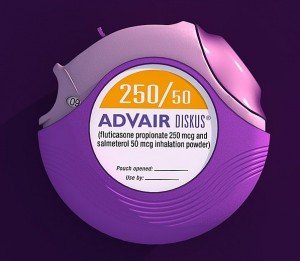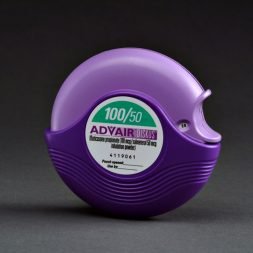The main contraindications are:
- children under 4 years old;
- hypersensitivity to drug components.
[ithshop code=”advair” tpl=”short” page_id=”969″ dummy=”txt”]
With Caution
- As with all inhaled medication containing glucocorticosteroids, Advair (what is it?) should be used with caution by patients with acute or latent pulmonary tuberculosis.
- thyrotoxicosis.
- fungal, viral or bacterial respiratory system infections.
- When you receive any drug of sympathomimetic group, particularly in does higher than therapeutic, development of cardiovascular complications such as increase in systolic arterial blood pressure and heart rate is possible. For this reason, the drug should be used with caution by patients with cardiovascular diseases, including arrhythmias such as supraventricular tachycardia and extrasystole, ventricular arrhythmia, atrial fibrillation.
- All sympathomimetic drugs in doses exceeding therapeutic, may cause transient potassium level in blood plasma decrease. Therefore, Advair should be used with caution at patients with hypokalemia.
- Any inhaled corticosteroid may cause systemic effects, especially at prolonged use at high doses. Therefore, the drug should be used with caution at glaucoma, cataracts and osteoporosis.
- There are very rare reports of increased blood glucose level, so diabetics should be cautious.
Side Effects
Data from clinical studies:
- infectious and parasitic diseases: often – mouth and throat candidosis, pneumonia (patients with COPD);
- immune system disorders: hypersensitivity reactions:
- infrequent – skin hypersensitivity reactions, dispnea;
- rare – anaphylactic reactions;
- endocrine system disorders: possible systemic effects include:
- infrequent — cataract;
- rare — glaucoma;
- metabolism and nutrition disorders:
- rare — hyperglycemia;
- very rare — hypokalemia;
- mental disorders:
- infrequent – anxiety, sleep disorders
 ;
; - rare – behavioral changes, including hyperactivity and irritability (especially among children);
- infrequent – anxiety, sleep disorders
- nervous system disorders:
- very often — headaches;
- infrequent — tremor;
- cardiac system disorders:
- infrequent — rapid heartbeat, tachycardia, atrial fibrillation;
- rare – arrhythmias, including ventricular arrhythmia, supraventricular tachycardia and extrasystoles;
- respiratory system, thoracic and mediastinal organs disorders:
- often – hoarseness and / or dysphonia;
- rare – throat irritation;
- skin and subdermal tissues disorders: infrequent — bruises;
- musculoskeletal and connective tissues disorders: often – muscle spasms, arthralgia.
Post-approval observation data:
- immune system disorders: hypersensitivity reactions: rare – angioedema (mainly facial and oropharynx swelling), bronchospasm;
- endocrine system disorders: possible systemic effects include rare – Cushing’s syndrome, Cushingoid symptoms, adrenal function suppression, growth retardation at children and adolescents, bone mineral density decrease;
- respiratory system, thoracic and mediastinal organs disorders: rare – paradoxical bronchospasm.
Pregnancy and Lactation Period
Pregnant and lactating women should be prescribed the drug only if expected benefit for the mother outweighs any possible risk for the fetus. There are insufficient data on salmeterol and fluticasone propionate use during pregnancy and lactation period.
Pregnancy
Reproductive toxicity of the drug and its components was studied during preclinical researches. Excessive systemic active beta2-adrenergic agonists and GCS concentration affect fetus.
Extensive clinical experience shows that when using drugs of this group in therapeutic doses, these effects are not clinically significant. Salmeterol and fluticasone propionate have no genotoxicity.
Lactation Period
Salmeterol and fluticasone propionate concentration in blood plasma after Advair inhalation in therapeutic doses is extremely low, so concentration in breast milk should be as low. This fact is supported by studies on animals, where milk was examined for low salmeterol and fluticasone propionate concentrations. There are no data on salmeterol and fluticasone propionate concentrations in women’s breast milk during breastfeeding.
Posted by Dr. Himanshu Singh

 English
English Deutsch
Deutsch Français
Français Italiano
Italiano Español
Español Svenska
Svenska Português
Português 日本人
日本人 Dansk
Dansk Norsk
Norsk Suomi
Suomi Czech
Czech


